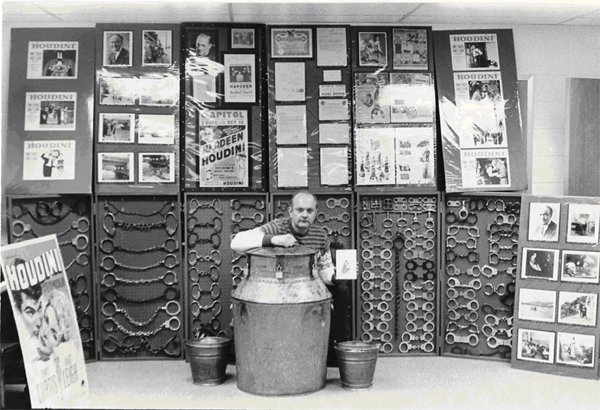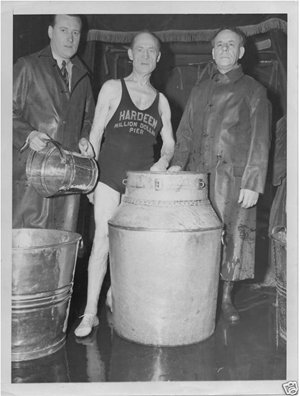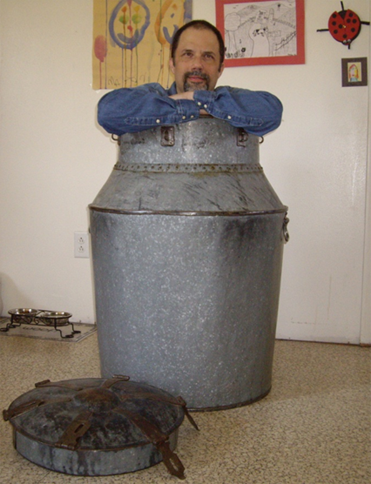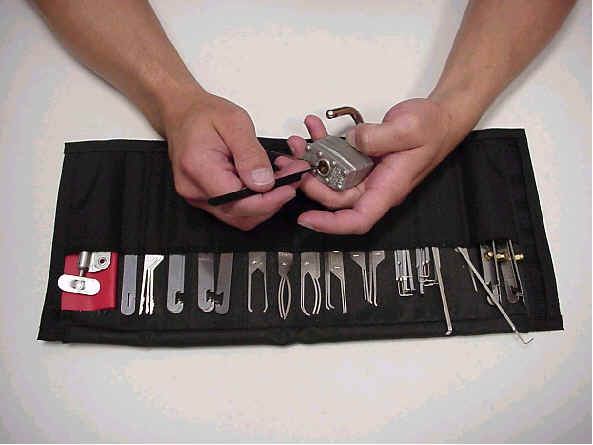Unlocking History
 Donald R. Hinz
Donald R. Hinz
 Theo Hardeen (middle)
Theo Hardeen (middle)
with his assistants
Douglas Geoffrey and Jim Vickery
I remember how excited he was when I had the good fortune to acquire a pair of handcuffs that had belonged to Theo Hardeen (Houdini’s brother). The visits with Don were a great time in my life and I’ve kept notes from the stories and history he shared with me.
Our friendship of over 35 years was ended abruptly when Don passed in 2011. Three years later I was called by Don’s son Eric to help solve a unique problem he had. In 1972 Don had purchased Hardeen’s milk can escape from Martin Sunshine, a friend of Hardeen’s, who lived in Three Lakes, Wisconsin. Hardeen had patterned the can after the one Houdini used and had it built in 1928. Eric had now inherited the milk can but it was locked and he needed it opened. I immediately made arrangements to stop by and unlock the famous apparatus. The can had not had the lid off for over 25 years and we wondered what we might find inside! I took out my lock picks and tools and quickly removed the six padlocks from the giant galvanized can.
With all the locks off I gave Eric the honor of removing the lid as the tension in the room began to build to a promising climax. Eric called his wife into the room and we all peered into the dark interior. Just like the majority of locked safes I’ve opened, the can was disappointingly empty! “But wait—we’d better make sure,” I said with a sly grin, taking the opportunity to get inside the can and play with it more. Like the proverbial kid in a candy store I had Eric put the lid on the steel prison while I, from the inside, tried to imagine how many performances the can had been used in and how many times Hardeen had escaped “a drowning death.” Upon closer examination the can was found to be expertly made and tricked in exactly the way I surmised. In this case, however, the secret or “trick” was the most outstanding feature of all. It was done with such precision and care that I marveled at the tight tolerances—a true testimony to the craftsmanship of the time. I shook hands with Eric thanking him for the chance to unlock this rare piece of history and recapture my childhood again, even if for a just a short time.
 Unlocking the Famous Milk Can
Unlocking the Famous Milk Can Getting the “Inside” Story
Getting the “Inside” Story
 Davenport Brothers early poster circa 1865
Davenport Brothers early poster circa 1865Escape History/Philosophy
Samri Baldwin claimed to have performed the first handcuff escape in the United States in 1871, three years before Ehrich Weiss—now known as Harry Houdini—was even born. Escapes themselves were often packaged as part of spiritualistic experiments or magical illusions, the skill being used surreptitiously to produce an entirely different effect. A bound “medium,” for instance, would secretly escape and then be the apparent channel through which spirits rang bells or produced other physical phenomenon under cover of darkness. They would then slip back into their bonds before the lights came back on, to the astonishment of onlookers who were unaware of the clandestine escape. The specialization of the escape art seems to begin, however, around the time of the brothers Houdini and the rise of vaudeville. Many of these performers were true lock technicians; some used fake handcuffs exclusively while others blended the two elements.
Over the past several decades, the increased availability of tricked locks and handcuffs has quickly produced a malformed fast food version of the escape artist that lacks technical substance. As a result, the technician has been supplanted by the pretender and the entire art has lost something of great value. This modern day unwillingness to invest sweat equity has diluted the craft and over time has resulted in the loss of many of its skill sets.
It has been my position that because these practices are so pervasive, the only way to preserve some semblance of the true art for future generations is to specialize and use only real locks and real handcuffs. To do otherwise is to relegate the escape artist to a mere caricature that is limited to contrived theatrical actions devoid of the spontaneity that at one time typified the art. The role of the escape artist is to personify freedom and push limits, not be shackled by them. As for me, I’ve chosen to do the work and remain true to the craft. I hope that future practitioners will see fit to do the same.







